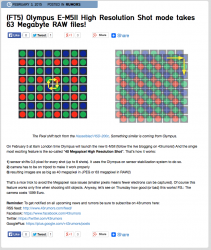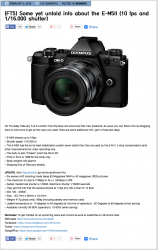By the end of the week Olympus should introduce the OMD E-M5 Mark II. It will evidently use the stabilization capability to micro shift the sensor, combine multiple images to create 40MB jpg files or 63MB raw files. Naturally this is shooting still objects, not sports or wildlife. Don't know of a 35mm body producing 60+MB raw images. Evidently the ISO range will be extended, the shutter speed goes up, and the high speed frame rate goes to 10fps. It should be shipping by the end of the month.
I can't wait to hear of a E-M1 Mark II.
I can't wait to hear of a E-M1 Mark II.



